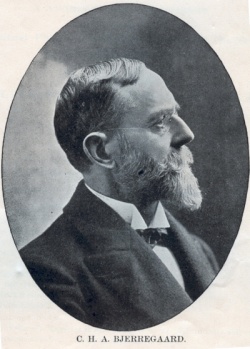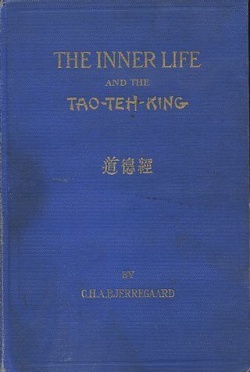Carl Henrik Andreas Bjerregaard
ARTICLE UNDER CONSTRUCTION
All who seek the roots of life dig in solitude for them. - C.H.A. Bjerregaard[1]
Carl Henrik Andreas (C.H.A.) Bjerregaard (1845-1922) was born in Denmark in 1845. Graduating from the University of Copenhagen in 1863, he went on to become a professor of botany. In 1873 he came to America and in 1879 became Librarian at the Astor Library, which later merged with the Lenox Library to form the Reference Division of the New York Public Library, eventually becoming Chief of its Main Reading Room. His interest in the spiritual life can be seen in the books and articles he wrote. This may explain the extensive collection of theosophical material at the New York Public Library.[2]
Bjerregaard was a longtime student of mysticism and oriental thought, having studied European scholarship on the topic prior to his immigrating, and Transcendentalism and New Thought afterward. He had become affiliated with the New York Theosophical branch by early 1886 and began giving the group several lectures on various esoteric topics. Bjerregaard also wrote for Judge's new journal, The Path, a series of articles on Sufism, which ran from May through October of 1886.[3]
Citation in The Secret Doctrine
In The Secret Doctrine, volume 1, p. 630, HPB quotes “the opinion of this learned and thoughtful theosophist, Mr. C. H. A. Bjerregaard,” on the Monad, from his “excellent paper on ‘The Elementals, the Elementary Spirits, and the relationship between them and Human Beings,’” read by him at the Theosophical Society in New York, and printed in The Path, Jan. and Feb. 1887: Every monad is a living mirror of the universe, within its own sphere. And mark this, for upon it depends the power possessed by these monads, and upon it depends the work they can do for us: in mirroring the world, the monads are not mere passive reflective agents, but spontaneously self-active; they produce the images spontaneously, as the soul does a dream. In every monad, therefore, the adept may read everything, even the future. Every monad or Elemental is a looking-glass that can speak.[4]
Biography
A one-time spy for the Danish military, Carl H. A. Bjerregaard (1845–1922) hastily left Denmark in 1873, a twenty-eight-year-old lieutenant absent without leave, and headed for New York. In the United States Bjerregaard started a new life, first as a factory worker in New Jersey, and then through employment at the Astor Library (soon to form the core of the New York Public Library). In Denmark he had briefly helped curate a natural history museum, so his joining the library staff in 1879 to classify books and recatalog them was not wholly out of character. Soon his military service faded into the past; he spent the rest of his career with the New York Public, eventually heading up the main reading room. That was only his day job, though. In his spare time, with all the library’s resources at his fingertips, Bjerregaard fashioned himself into a philosopher, artist, and mystic.
By the 1890s, he was lecturing widely on mysticism, nature worship, and kindred topics. “I address you as Pilgrims of the Infinite,” Bjerregaard told an audience in Chicago in 1896, “for you are pilgrims; I can see that on your faces. You are not pilgrims either from or to the Infinite, but you are of the Infinite. From and to indicate space and time relations, but in the Infinite we recognize neither time nor space; there is no to-day and to-morrow; no here and no there. Eternity is no farther off from the Mystic, than the moment in which he speaks. You are Pilgrims OF the Infinite.” Bjerregaard’s summons to explore the “Mystic Life” was heady stuff. It was, among other things, an affirmation of the supreme freedom of spiritual aspirants to seek the truth for themselves and within themselves. The call seemed to resound everywhere: Bible passages, Taoist sayings, pine trees and cones, Jewish Kabbalah, Zoroastrian fire imagery, yoga, Sufi poetry, American Transcendentalism, and the Christian mythology of the Holy Grail.
Bjerregaard’s spirituality, like the faith of Ralph Waldo Emerson (1803–1882), was especially in synchrony with the American lecture circuit. Bjerregaard’s favorite place to speak was Greenacre, the summer community that the visionary Sarah Farmer (1847–1916) founded in Eliot, Maine, in 1894. He saw Farmer’s experiment as a realization of his ideas about a universal mysticism and was lavish in his praise of its design. When he gave personal examples of his own exalted experiences, they almost always circled back to Greenacre, whether to a sunrise worship service led by the Zoroastrian Jehanghier Cola or to barefoot walks on the dew-drenched grass. “Greenacre is a revelation,” Bjerregaard remarked. “When you rise from the cool waves of the Piscataqua [River], you rise out of the quiet place of your own soul.” As a lecturer, Bjerregaard believed in presentations that were personal and experiential; like Emerson, he did not want to offer secondhand news or disinterested scholarship. Make lecturers, he said, “give their own experiences and not something they have read in books and only poorly digested.... In soul life no abstract teachings are worth much.”[5]
Obituary
C.H.A. BJERREGAARD, LIBRARIAN, DIES AT 76
Authority and Writer on Mysticism Taught Himself Painting at Age of 70.
Carl Henry Andrew Bjerregaard, chief of the reading room of the New York Public Library and an authority on mysticism, died yesterday morning at his residence, 541 West 124th Street, in his 77th year. He had been conected [sic] with the public libraries of this city since he first found employment with the old Astor library in 1879.
Born in the town of Frederica, Denmark, the feudal seat of his Viking ancestors, Bjerregaard graduated from the University of Copenhagen in 1863 and from the Military Academy of Denmark in 1866, serving five years in the Danish Army. After a brief period with the Danish Legation at St. Petersburg he came to this country for political reasons in 1873. A time of hardship followed until his scholarly attainments gained him a permanent position.
In addition to lecturing on mysticism and various Oriental beliefs, the [sic] wrote many books on such subjects as "Mysticism and Nature Worship," "Sufi Interpretation of Omar Khayyam and Fitzgerald" and "The Great Mother," the last treating the connection between the mystic passion and nature worship. In accordance with his view that youth is preserved by the adoption of a new productive activity, he taught himself painting at the age of 70 and produced several hundred sketches and pictures in oil and water color, drawing entirely from memory, some of the scenes beheld only in his dreams. [6]
Writings/Lectures
The Union Index of Theosophical Periodicals lists 24 articles by or about Bjerregaard.
His books include: Lectures on mysticism and nature worship, 1896 and 1897; Sufi interpretations of the quatrains of Omar Khayyam and Fitzgerald, 1902; Jesus: a poet, prophet, mystic and man of freedom, 1912; The inner life and the Tao-teh-king, 1912; The great mother, a gospel of the eternally-feminine; occult and scientific studies and experiences in the sacred and secret life, 1913; Sufism: Omar Khayyam and E. Fitzgerald, 1915.[7]
C.H.A. Bjerregaard’s articles in The Path began with a six part series on “Sufism,” starting in the May 1886 issue, and followed by “The Elementals, the Elementary Spirits, and the Relationship between them and human beings,” a paper read before the Aryan T.S. of New York, Dec. 14, 1886, and published in The Path, Jan. and Feb. 1887.
An extensive Bibliography of C.H.A. Bjerregaard is included in the biography by Lars Rasmussen, C.H.A. Bjerregaard og Det Indre Liv: en Dansk Mystiker i New York [C.H.A. Bjerregaard and the Inner Life: a Danish Mystic in New York]. .[8]
Notes
- ↑ Sy Safransky, Sunbeams: A Book of Quotations (Berkeley, California: North Atlantic Books, 1990), 125.
- ↑ http://blavatskynews.blogspot.com/2010/05/c-h-bjerregaard.html
- ↑ Patrick D. Bowen, A History of Conversion to Islam in the United States, Volume 1: White American Muslims before 1975. (Leiden | Boston: Brill, 2015),100.
- ↑ http://blavatskynews.blogspot.com/2010/05/c-h-bjerregaard.html
- ↑ Leigh Eric Schmidt, Restless Souls: The Making of American Spirituality. (San Francisco: HarperSanFrancisco, 2005), 25-27.
- ↑ The New York Times, January 28, 1922.
- ↑ http://blavatskynews.blogspot.com/2010/05/c-h-bjerregaard.html
- ↑ Lars Rasmussen, C.H.A. Bjerregaard og Det Indre Liv: en Dansk Mystiker i New York. (Copenhagen, The Booktrader, 2016),100.

